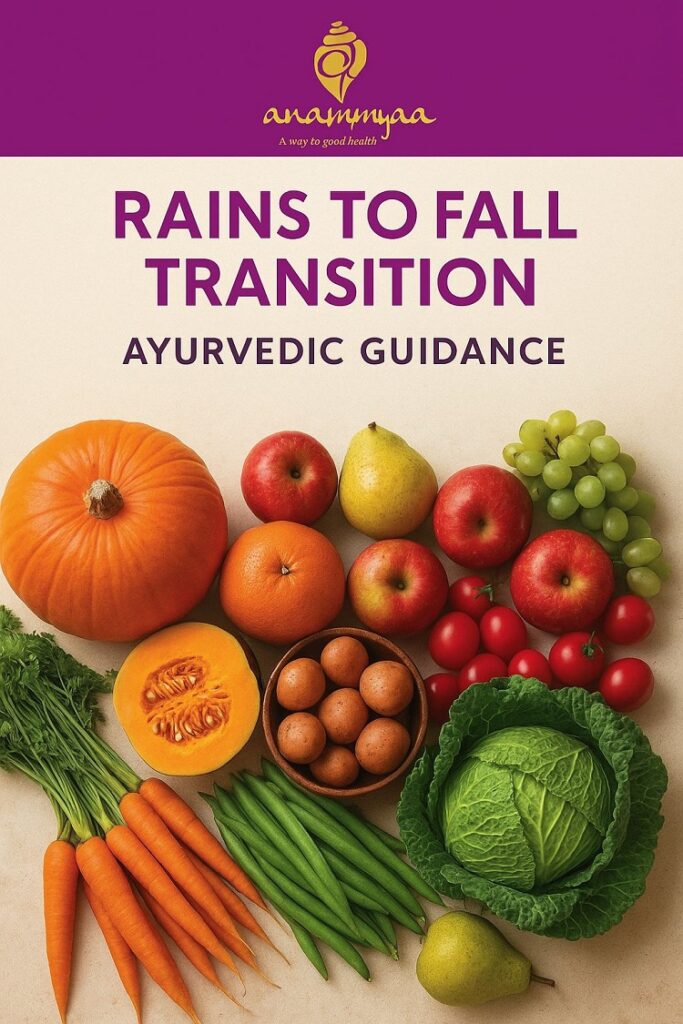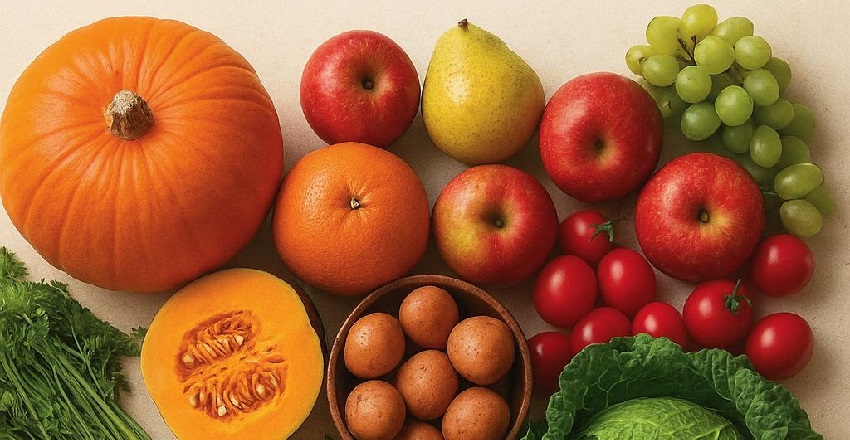As the heavy monsoon clouds drift away and the bright, golden light of autumn takes over, India celebrates Dussehra — the victory of good over evil, light over darkness. In Ayurveda too, this period is seen as a time of transition: moving from Varsha Ritu (rains) into Sharad Ritu (fall).
This shift is known as Ritu Sandhi, a seasonal junction where the body is most vulnerable. Just as nature changes her rhythm, our body, mind, and digestion also undergo transformations. Aligning with this wisdom through seasonal eating and lifestyle is the key to preventing disease and maintaining balance.
The Ayurvedic Lens: Varsha Ritu → Sharad Ritu
- Varsha Ritu (Monsoon): Damp, heavy, kapha-aggravating, with weak digestion (Agni). Water-borne infections, sluggishness, and respiratory issues are common.
- Sharad Ritu (Autumn): Dry, bright, pitta-dominant, with sharp sunlight and an increase in acidity, skin issues, and fevers. As cool breezes arrive, Vata also begins to rise.
This is why Ritu Sandhi (transition period) demands careful food and lifestyle adjustments — to protect Agni, balance doshas, and prevent seasonal diseases.
Common Diseases in the Rains-to-Fall Transition
- Fevers & Viral Infections – sudden climate changes lower immunity.
- Skin Disorders – rashes, allergies, and acne due to pitta aggravation.
- Acidity & Gastric Issues – strong autumn sun flares up digestive heat.
- Respiratory Problems – lingering kapha from rains + dryness → cough, asthma flare-ups.
- Fatigue & Mood Swings – Vata disturbance affects both mind and body.

Seasonal Eating According to Ayurveda
Ayurveda reminds us: “As is the season, so must be the diet.”
The foods that nourished us during the rains must now be phased out, and warming, grounding foods introduced to prepare for fall and upcoming winter.
Foods to Include
Grains:
- Khapali wheat, Sona Moti wheat, old rice.
- Ragi and Bajra — warming and grounding, excellent as weather turns cooler.
- Jowar should be strictly avoided now — it is cooling and drying, which aggravates Vata and weakens digestion in this season.
- Vegetables: Shift away from cooling gourds (bottle gourd, ridge gourd, ash gourd). Instead, choose:
- Cauliflower, beans, cabbage, carrots, beets, and seasonal green leafy vegetables (methi, spinach, bathua) as fall deepens into winter.
- Fruits: Pomegranate, apple, pear, guava, amla — pitta-pacifying, aid digestion.
- Healthy Fats: A2 Gir cow ghee — essential to counter dryness of millets and the seasonal rise of Vata. Sesame oil may also be used in cooking and abhyanga (oil massage).
- Spices: Cumin, coriander, turmeric, cinnamon, cardamom — gently warming, maintain Agni.
- Herbal decoctions: Giloy, tulsi, amla, cinnamon (in moderation) — for immunity and seasonal adaptation.
Foods to Avoid
- Jowar and barley (cooling + drying, not suitable for fall/winter).
- Gourds and watery vegetables after rains.
- Fermented, sour, fried foods — aggravate pitta, disturb digestion.
- Heavy dairy (paneer, cheese, curd) — kapha-aggravating.
- Very pungent/spicy foods — trigger acidity.
- Cold drinks, ice creams — weaken Agni.
Lifestyle & Rituals for Balance
- Panchakarma & Detox: Autumn is ideal for pitta-pacifying therapies and mild cleansing.
- Abhyanga (oil massage): Use sesame or cooling oils to nourish dryness and pacify Vata.
- Clothing: Switch to warmer fabrics as evenings turn cooler.
- Rituals & Fasting: Gentle fasting on fruits or light meals helps reset digestion.
- Festive Moderation: Enjoy Dussehra sweets, but balance with light meals and herbal teas.
Dussehra & the Inner Victory
Dussehra reminds us of the eternal triumph of light over darkness. Ayurveda teaches a similar inner victory — when we learn to conquer disease, imbalance, and disorder by living in harmony with nature’s cycles.
By eating and living seasonally, we prevent illness before it arises — the highest form of health according to Ayurveda.
Key Ayurvedic Tips for This Transition
- Start your morning with lukewarm water infused with fennel or coriander.
- Add A2 Gir cow ghee generously to meals, especially when consuming millets.
- Favor warming vegetables over cooling gourds.
- Support immunity with amla, giloy, tulsi, and Swarnaprashan for children.
- Practice pranayama and meditation to balance seasonal Vata.
The rains-to-fall transition is not just a change in weather — it is a reminder to adapt our inner rhythm with the outer world. By following Ayurvedic Ritucharya, we protect Agni, balance doshas, and ensure resilience against seasonal diseases.
As we celebrate Dussehra, let’s also celebrate victory over imbalance by living in tune with nature.
At Anammyaa Wellness, we bring this timeless Ayurvedic wisdom into your daily life through consultations, therapies, and seasonal detox programs.
Connect with us at 95600-24178 or visit www.anammyaawellness.com to begin your journey into seasonal health.
Discover more contact us today



